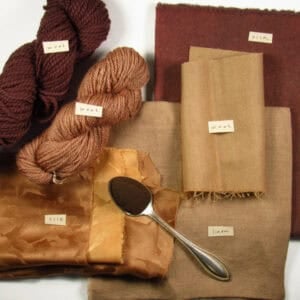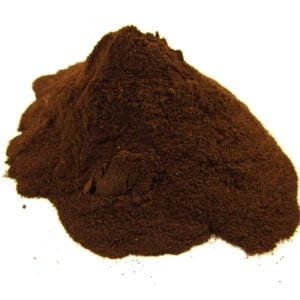Our walnut powder consists of finely ground dried hulls of the black walnut tree. It is a very strong dye and is used to make a silvery beige to nearly black. In old time natural dye recipes, it is often used as a “bottom” or base dye for indigo to create beautiful dark blue and blue-black.
Fiber Preparation and Mordanting
We offer scouring instructions for wool, alpaca, silk (protein), cotton and plant (cellulose) fibers. It is not necessary to mordant prior to dyeing with walnut powder, but many dyers prefer to mordant all their yarns. Note that aluminum sulfate (alum) will impart a more golden tone to the walnut.
Extracting the Dye
For the darkest shades, use 100% walnut powder on the weight of fiber. For medium shades, use 50% walnut powder, and for light shades use 10-40% on the weight of fiber.
In a small stockpot or other vessel, cover the walnut powder with water. Simmer the walnut powder over low flame for 2 hours, adding water as necessary and stirring occasionally. Carefully pour off the dark brown liquid. This is your dye bath. Save the walnut grounds: they may be extracted a number of times to yield lighter shades, or dried and reused.
Adding Fibers to the Pot
Fill the dye pot with water so that the fibers move easily. Add the brown extracted liquid and stir well. Add wet fibers to the cold dye pot and begin heating the water and bring to about 90 degrees F (33 degrees C), rotating the goods gently. Hold at this warm temperature for 30 minutes, then bring the temperature up gradually to 180 degrees F (80 degrees C), rotating gently. Hold at this temperature for 30-45 minutes rotating regularly.
Rinsing
Using the same temperature water as your fiber, rinse the dyed goods once or twice to remove excess dye, then wash gently in a neutral liquid soap. Dry away from direct sunlight.
Reusing Dye Baths and Disposal of Dye
Any exhaust baths with dye color left in them may be used to dye additional materials. I keep extra small skeins of mordanted wool yarn and throw those into the exhaust baths. There will usually be some residual color in the dyebath, even after using the exhaust bath. Dispose of the used dye baths in accordance with your local municipal guidelines.
Darkening walnut shades
Walnut will impart a very dark tone if iron (ferrous sulfate) is used as either a pre-mordant, a post-bath or in the dye bath. The use and amount depends upon the fiber being dyed. Wool and other protein fibers tend to weaken in a boiling iron solution, so a lukewarm post-bath of 1% iron dissolved in cool water is recommended. Dip the fiber in the lukewarm bath until the color changes. For cotton or other cellulose fibers, it is possible to add iron to the dye bath. For cotton, you may use up to 3% iron on the weight of the dry fiber dissolved in cold water and added to the dye bath.


